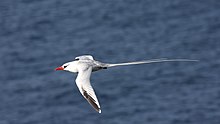| Phaethontiformes Temporal range: Early Paleocene - present PreꞒ Ꞓ O S D C P T J K Pg N Possible Maastrichtian record | |
|---|---|

| |
| Red-billed tropicbird | |
| Scientific classification | |
| Domain: | Eukaryota |
| Kingdom: | Animalia |
| Phylum: | Chordata |
| Class: | Aves |
| Clade: | Eurypygimorphae |
| Order: | Phaethontiformes Sharpe, 1891 |
| Families | |
The Phaethontiformes /ˌfeɪ.ɪˈθɒntɪfɔːrmiːz/ are an order of birds. They contain one extant family, the tropicbirds (Phaethontidae), and one extinct family Prophaethontidae from the early Cenozoic. Several fossil genera have been described, with well-preserved fossils known as early as the Paleocene. The group's origins may lie even earlier if the enigmatic waterbird Novacaesareala from the latest Cretaceous or earliest Paleocene of New Jersey is considered a tropicbird.
Many phaethontiform fossil taxa are known from the Paleocene and Eocene, but the fossil record becomes much more scant after the Oligocene. This suggests that around this time, the group may have moved out of the nearshore habitats where they were easier to fossilize and evolved the pelagic lifestyle that is still retained by the few surviving members today.
The tropicbirds were traditionally grouped in the order Pelecaniformes, which contained the pelicans, cormorants and shags, darters, gannets and boobies and frigatebirds; in the Sibley-Ahlquist taxonomy, the Pelecaniformes were united with other groups into a large "Ciconiiformes". More recently this grouping has been found to be massively non-monophyletic (missing closer relatives of its distantly related groups) and split again. Microscopic analysis of eggshell structure by Konstantin Mikhailov in 1995 found that the eggshells of tropicbirds lacked the covering of thick microglobular material of other Pelecaniformes.
Some early studies in the last decade suggested Phaethontiformes were distantly related to Procellariiformes, but since 2004 they have been placed in Metaves, or in a lineage with no affinities with Procellariiformes, by the results of most recent molecular studies. Jarvis, et al.'s 2014 paper "Whole-genome analyses resolve early branches in the tree of life of modern birds" aligns the Phaethontiformes most closely with the sunbittern and the kagu of the Eurypygiformes, with these two clades forming the sister group of the "core water birds", the Aequornithes, and the Metaves hypothesis abandoned.
References
- Mayr, G.; De Pietri, V. L.; Love, L.; Mannering, A.; Crouch, E.; Reid, C.; Scofield, R. P. (2023). "Partial skeleton from the Paleocene of New Zealand illuminates the early evolutionary history of the Phaethontiformes (tropicbirds)". Alcheringa: An Australasian Journal of Palaeontology. 47 (3): 315–326. Bibcode:2023Alch...47..315M. doi:10.1080/03115518.2023.2246528.
- ^ Mayr, Gerald; De Pietri, Vanesa L.; Love, Leigh; Mannering, Al; Crouch, Erica; Reid, Catherine; Scofield, R. Paul (2023-07-03). "Partial skeleton from the Paleocene of New Zealand illuminates the early evolutionary history of the Phaethontiformes (tropicbirds)". Alcheringa: An Australasian Journal of Palaeontology. 47 (3): 315–326. Bibcode:2023Alch...47..315M. doi:10.1080/03115518.2023.2246528. ISSN 0311-5518.
- Mayr, Gerald; Scofield, R. Paul (2016-01-02). "New avian remains from the Paleocene of New Zealand: the first early Cenozoic Phaethontiformes (tropicbirds) from the Southern Hemisphere". Journal of Vertebrate Paleontology. 36 (1): e1031343. Bibcode:2016JVPal..36E1343M. doi:10.1080/02724634.2015.1031343. ISSN 0272-4634. S2CID 130026060.
- Mikhailov, Konstantin E. (1995). "Eggshell structure in the shoebill and pelecaniform birds: comparison with hamerkop, herons, ibises and storks". Canadian Journal of Zoology. 73 (9): 1754–70. doi:10.1139/z95-207.
- Mayr, G (2003). "The phylogenetic affinities of the Shoebill (Balaeniceps rex)". Journal für Ornithologie. 144 (2): 157–175. Bibcode:2003JOrni.144..157M. doi:10.1007/bf02465644. S2CID 36046887.
- Bourdon, E.; et al. (2005). "Earliest African neornithine bird: A new species of Prophaethontidae (Aves) from the Paleocene of Morocco". J. Vertebr. Paleontol. 25 (1): 157–170. doi:10.1671/0272-4634(2005)025[0157:eanban]2.0.co;2. S2CID 86218884.
- Fain, M.G.; Houde, P. (2004). "Parallel radiations in the primary clades of birds". Evolution. 58 (11): 2558–73. doi:10.1554/04-235. PMID 15612298. S2CID 1296408.
- Ericson, G.P.; et al. (2006). "Diversification of Neoaves: integration of molecular sequence data and fossils". Biol. Lett. 2 (4): 543–547. doi:10.1098/rsbl.2006.0523. PMC 1834003. PMID 17148284.
- Hackett, S.; et al. (2008). "A Phylogenomic Study of Birds Reveals Their Evolutionary History". Science. 320 (5884): 1763–1768. Bibcode:2008Sci...320.1763H. doi:10.1126/science.1157704. PMID 18583609. S2CID 6472805.
- Naish, D. (2012). "Birds." Pp. 379–423 in Brett-Surman, M.K., Holtz, T.R., and Farlow, J. O. (eds.), The Complete Dinosaur (Second Edition). Indiana University Press (Bloomington & Indianapolis).
- Jarvis, Erich D.; et al. (2014). "Whole-genome analyses resolve early branches in the tree of life of modern birds". Science. 346 (6215): 1320–1331. Bibcode:2014Sci...346.1320J. doi:10.1126/science.1253451. PMC 4405904. PMID 25504713.
| Taxon identifiers | |
|---|---|
| Phaethontiformes | |